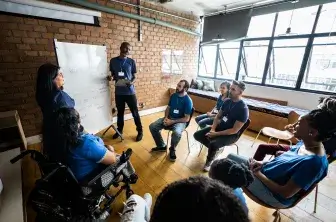Strategy 3: Mobilize Investment
Streamline Permitting

One of the biggest barriers to building new infrastructure is permission: the legal and regulatory approvals needed before construction begins. At the federal, state, and local levels permitting laws play an important role in protecting the environment. However, they can also slow down projects that would reduce emissions and defend against climate change, often with little or no environmental and social benefit. This must be changed.
Streamline the permitting process by adopting promising practices at federal, state, and local levels.
Continue to reform permitting without meaningfully compromising the quality or inclusivity of environmental review, while giving siting authority to federal agencies for high value energy projects.
Use promising practices to determine and consider cumulative impacts to reduce the potential pollution burden on frontline communities.
More recommendations
Cutting emissions and making society more resilient to the effects of climate change will require new infrastructure, such as transmission lines and improved water handling and treatment systems. Yet due to the current regulatory environment, the actual building of this infrastructure lags far behind what is needed. For example, the U.S. electric transmission system currently expands by 1 percent per year but must move closer to 2.3 percent annually to achieve deep decarbonization.[i]
Expanding this key infrastructure more rapidly will require reforms to permitting processes, which at present can slow projects by years and deter investors from pursuing some projects altogether. But permitting is one of the nation’s tools for ensuring that projects do not cause undue harm to the environment or the health of surrounding communities. Infrastructure with such harmful effects exacerbates existing inequities when near low-wealth communities or communities of color. Applying a justice lens to reforms to permitting processes makes it easier for low-income communities to gain clean energy.
Streamline the permitting process by adopting promising practices at federal, state, and local levels.
It is possible to improve and accelerate the permitting process for siting new clean energy infrastructure using existing legislative authority. Many of the most promising opportunities lie with broadening participation early in project planning so developers can better anticipate resistance and adjust designs, especially for multijurisdictional projects. Such transparent engagement increases trust between communities, government agencies, and project developers. It may also reduce the odds of lawsuits when the project approaches completion.
Achieving deeper and earlier engagement requires that government agencies continue to identify and share promising practices for broadening early participation, especially for making the permitting process accessible to nonexperts. It also requires adequate funding to train personnel in federal agencies on how to engage on environmental justice issues. In addition, Congress should amend the Federal Advisory Committee Act to allow convenings of agencies, project proponents, industry, tribes, and state and local governments without cumbersome notification and other constraints.[ii]
Permitting regulations at the state and local levels can pose additional complications. Most localities have zoning laws that restrict a wide variety of new developments. The National Renewable Energy Laboratory has identified nearly two thousand siting ordinances on wind power and one thousand on solar power.[iii] Infrastructure projects that cross state and municipal boundaries often must engage with a patchwork of regulations, complicating approval processes for projects as a whole. To ease the permitting of clean energy, electricity transmission, and resilience projects, federal funding should be contingent on state and municipal adherence to a unified set of guidelines.[iv] These guidelines should be similar to those in the federal government’s FAST-41 program, created in 2015 to accelerate infrastructure in certain sectors.
Continue to reform permitting without meaningfully compromising the quality or inclusivity of environmental review, while giving siting authority to federal agencies for high value energy projects.
Historically, the permitting process has been slow and has favored developers with the capital and lawyers to navigate the process.[v] But to achieve just outcomes, projects of all types must advance, especially those that advantage frontline communities. The Fiscal Responsibility Act, passed in June 2023, contains reforms to the National Environmental Policy Act (NEPA) designed to speed up the permitting process by limiting times for review and exempting some projects from major reviews.[vi] The reforms also narrow the scope of environmental effects and options for alternatives under reasonableness standards, while providing the opportunity for greater state, local, and tribal engagement through lead and cooperating agency roles. Further reforms to the NEPA and other permitting processes should maintain the quality of environmental review while removing existing barriers to build green infrastructure.
A promising development is the new “backstop” authority given to the Federal Energy Regulatory Commission (FERC) by the Infrastructure Investment and Jobs Act to site particularly valuable electric power lines. The FERC is proposing that developers submit an environmental justice public engagement plan and an environmental justice resource report. So environmental justice communities can have a well-articulated, influential voice in this process, developers and government should fund environmental justice and Indigenous liaisons. The establishment of a mandatory funded account could be a meaningful reform to provide funding for this purpose.
Projects that are predesignated by federal agencies to be low-risk, clean energy projects and those that are outside of federal land are candidates for exemption from lengthy federal review processes. Already many federal agencies, including DOE, are advancing efforts to identify these high priority, low-risk infrastructure projects. Additionally, the North American Electric Reliability Corporation will be carrying out a study to identify where key transmission projects may be needed.[vii] Having the government engage in programmatic reviews for solar, wind, and transmission projects could help proponents make more informed siting decisions that have comprehensive benefits.
To preempt disputes and facilitate resolution outside of the courts, litigants could be required to submit feedback during the public comment period. Alternatively, the statute of limitations could be shortened, decreasing the period when projects could become enmeshed in litigation. As an alternative to the court system, the Federal Permitting Improvement Steering Council (FPISC) should be empowered to resolve interagency disputes, and the director of the FPISC should be a Senate-confirmed position that reports to the President. Remaining lawsuits could also be directed to a specialized court with expertise on NEPA and conservation that many courts lack. Despite many reforms included in the Fiscal Responsibility Act that could speed up agency reviews, the fundamental problems created by looming litigation on the content of those reviews remain largely unchanged.
Use promising practices to determine and consider cumulative impacts to reduce the potential pollution burden on frontline communities.
Cumulative impacts refers to the combined effects of multiple environmental stressors on communities, especially those that are already facing multiple burdens, such as pollution, poverty, and lack of political agency. Permitting decisions that fail to consider cumulative impacts can result in the concentration of environmental hazards in certain areas, which can further exacerbate existing inequalities and decrease broad public will for climate action. For example, a community may be burdened with multiple sources of pollution, such as a power plant, a refinery, and a waste facility, leading to higher levels of air and water pollution and associated health risks.
To ensure these impacts are considered and distributed more fairly, the federal government should develop standards on how to measure them. Many federal, state, and local mitigation and adaptation projects already include assessments and mitigation of cumulative impacts in their planning. For example, the Light Rail Transit Project in Phoenix created a model that considered air and water quality, noise pollution, and impact on existing traffic that they shared with local community members in outreach sessions. Based on this model and community feedback, the builders changed the plans to better protect water quality and not disturb sensitive habitats. To expand cumulative impacts analysis and demonstrate how to improve current practices, philanthropy should identify high-value projects that could benefit from more systematic assessments and invest in a sample of them.
[i] Jesse D. Jenkins, Jamil Farbes, Ryan Jones, et al., Electricity Transmission is Key to Unlock the Full Potential of the Inflation Reduction Act (Princeton, N.J.: REPEAT Project, Princeton University Zero Lab, 2022), https://doi.org/10.5281/zenodo.7106176.
[ii] U.S. General Services Administration, “The Federal Advisory Committee Act (FACA) Brochure: An Overview,” https://www.gsa.gov/policy-regulations/policy/federal-advisory-committee-management/advice-and-guidance/the-federal-advisory-committee-act-faca-brochure (accessed June 12, 2023).
[iii] Madeline Geocaris. “NREL Releases Comprehensive Databases of Local Ordinances for Siting Wind, Solar Energy Projects,” The National Renewable Energy Laboratory, August 9, 2022, https://www.nrel.gov/news/program/2022/nrel-releases-comprehensive-databases-of-local-ordinances-for-siting-wind-solar-energy-projects.html.
[iv] Aspen Institute, Building Cleaner, Faster (Washington, D.C.: Aspen Institute, 2021), https://www.aspeninstitute.org/wp-content/uploads/2021/06/Building-Cleaner-Faster-Final-Report.pdf.
[v] Jonathan M. Moch and Henry Lee, “The Challenges of Decarbonizing the U.S. Electrical Grid by 2035” (Cambridge, Mass.: Belfer Center for Science and International Affairs, Harvard Kennedy School, 2022), https://www.belfercenter.org/publication/challenges-decarbonizing-us-electric-grid-2035.
[vi] Stephen Lee, “Debt Deal Pares Federal Role in Environmental Permitting Reviews,” Bloomberg Law, May 30, 2023, https://news.bloomberglaw.com/environment-and-energy/debt-deal-pares-federal-role-in-environmental-permitting-reviews.
[vii] U.S. Department of Energy, National Transmission Needs Study: Draft for Public Comment (Washington, D.C.: U.S. Department of Energy, 2023), https://www.energy.gov/sites/default/files/2023-02/022423-DRAFTNeedsStudyforPublicComment.pdf.




